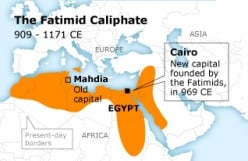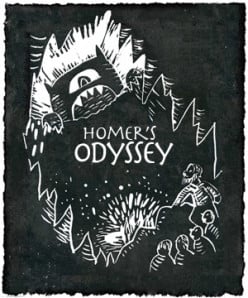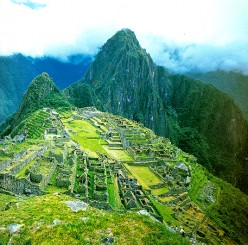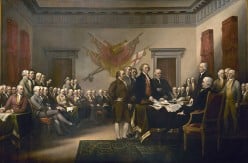 75
75- 3
Compare/Contrast of the American and French Revolutions
Bloodshed. Gunfire. Cries of victory. These are the themes that characterized the eighteenth century, which was described as “The Age of Revolution.” Two of the major revolutions of the eighteenth century, the French and American revolutions,...
- 0
Impacts of Islam in Africa: 1000-1750 AD
Upon a split between two doctrines of Islam, the Sunni's and the Shiites, a new Islamic dynasty was founded in Egypt called the Fatimid Dynasty. After the Fatimid invasion of Egypt, Islam began to permeate through the rest of Africa. Islam's spread...
- 0
Keats: A Literary Analysis
An analysis of John Keats's poem "On First Looking Into Chapman's Homer".
- 1
The Odyssey: A Literary Analysis
Oftentimes in literature, a physical journey is used to bring about a spiritual journey. How does the physical journey of the Odyssey affect Odysseus as a character and the greater meaning of the work
- 12
Changes and Continuities on the Silk Road
The Silk Road was a trading route, beginning in China and created during the Han Dynasty. Learn how the Silk Road changed over time and how it changed the world.
- 4
Methods of Political Control in the Roman and Gupta Empires
In the Classical Period, two great empires emerged as the most powerful nations on the map: Imperial Rome and Gupta India. The Gupta and Roman empires methods of political control were similar in their use of hereditary rule and imperialism, but...
- 0
Changes and Continuities in the Religious Practices of Latin America
Today, Latin America is a beautiful, tropic, thriving part of the world, which is known to be predominately Catholic in religion. However, Christianity was not always apart of Latin American culture. Initially, Latin American tribes were devout...
- 0
The Age of Revolution: America and France
Bloodshed. Gunfire. Cries of victory. These are the themes that characterized the eighteenth century, which was described as “The Age of Revolution.” Two of the major revolutions of the eighteenth century, the French and American revolutions,...
- 6
A Night at Netherfield: A Short Story
I didn’t know how to respond to my grandmother, who was ranting endlessly about the scandalous lives of her bridge club members, so I contented her with the occasional “hmm,” “wow,” or “oh, that’s interesting.” It was early morning....
- 0
Comparing and Contrasting the Effects of WWI on East and South Asia
When WWI began in the early 20th century it sparked a political tornado of change that swept over the entire world, augmenting everything in its path.
- 5
Goals and Outcomes of the Russian and Mexican Revolutions
Oppressive regimes. Peasants uprising. The rush of victory. The 20th century was a time of mass upheaval all over the world, where working-class people demanded more from their governments and took up arms to get it. Read on for more info about the Russian and Mexican revolutions.
- 0
Defining Nationalism: Issues of 20th Century Muslim Leaders
After World War II, Islamic South Asia and North Africa began to nationalize, separating from European regimes and creating their own identity. South Asia and North Africa, specifically India and Egypt, were confronted with several issues during the...
- 2
Compare and Contrast Essay of Women's Suffrage Movements in South America and Europe from 1750-1914
Intro Throughout history, women have played a vital role in society. From nurturing family life in the home to fighting in revolutions to participating in politics, women have shown constant bravery and sacrifice in the face of the world’s...
- 1
Changes in the Russian Labor System From 1750–1914
Russia's labor system changed drastically in the years between 1750 and 1914, largely due to the emancipation of Russian serfs. Read on for the full story.
- 2
History of Indentured Servitude Between the 18th and 19th Centuries
Indentured servitude (that is, owning servants who are paid for a certain number of years agreed upon by both parties) was popular in the seventeenth century, then died off before later having a resurgence in the eighteenth century. Why? Read on for an analysis of indentured servitude.
- 4
The Social, Economic, and Political Processes of Empire Building in the Spanish and Ottoman Empires
When building an empire, nations go through certain processes to promote their power and expansion, usually through society, politics, and the economy.
- 0
Differing AttitudesToward Technology in the Han and Roman Empires
Two of the most powerful empires of the ancient world were the Han, in China, and the Romans, in Italy. While both were great and powerful, Han and Roman similarities and differences in valued class, occupation, and government can be found in their attitudes toward technology.
- 0
Social and Economic Changes in the Atlantic World from 1492-1750 AD
From 1492 to 1750 the Atlantic World, which includes all of the continents whose borders touch the Atlantic Ocean, saw great change as explorers began to settle new worlds and trade expanded. Connections between Europe, Africa, and the Americas brought change socially and economically through the...
- 1
Economic and Social Effects of Silver From the 16th to the 18th Century
“The frugal man with only one bar of currency can have something left over, whereas the extravagant man with a thousand can still not have enough.” This short proverb from a Ming Dynasty official around 1570 illustrates how silver was the primary source of payment of the day. Silver dominated...
- 3
Impacts of Islam in Africa: 1000-1750 AD
Islam's spread from 1000 AD to 1750 AD impacted Africa socially, culturally, and politically by instituting the slave trade, creating a rise in education, and adding Muslim leaders to West Africa's history. Despite all of these changes, West Africa maintained some continuity as well.



















